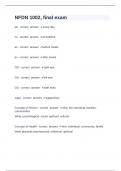NFDN 1002, final exam
qd - correct answer ✔every day
hs - correct answer ✔at bedtime
ac - correct answer ✔before meals
pc - correct answer ✔after meals
OD - correct answer ✔right eye
OS - correct answer ✔left eye
OU - correct answer ✔both eyes
supp - correct answer ✔suppository
Concept of Person - correct answer ✔who: the individual, families,
communities
What: psychological, social, spiritual, cultural
Concept of Health - correct answer ✔who: individual, community, family
what: physical, psychosocial, relational, spiritual
,Concept of environment - correct answer ✔who: individual, community,
family
what: internal & external environments, home life, mental state, addictions,
pain, sociocultural circumstances, religion, attitude toward death,
Concept of Nursing - correct answer ✔who: nurse in the relationship with the
patient
what: recognition of pt. as "experts" of their own lives, ethical care, dignity,
privacy & confidentiality, health & well- being promotion, respect for informed
decision making
Concept of Social Justice - correct answer ✔who: vulnerable( poor, people
with disabilities)
what: allocation of life's resources ( health-care access, water, food, shelter,
security, employment, income, safety services)I
intrapersonal communication - correct answer ✔what: self-talk ,inner thought
interpersonal communication - correct answer ✔what: face to face interaction
transpersonal communication - correct answer ✔what: interaction with a
spiritual domain
Small group communication - correct answer ✔who: doctor, nurse team,
physio, OT, pharmacist,
what: goal-directed
how: interaction when a small number of people meet together and meet a
common purpose
,Therapeutic communication. - correct answer ✔what: purposeful, goal-
directed
how: time limited communication
phases of therapeutic communication - correct answer ✔pre-orientation,
orientation, working phase, termination
Receiving and giving patients reports - correct answer ✔written & verbal
Receiving doctors orders - correct answer ✔verbal, by telephone, written,
electronic
Admission records - correct answer ✔biographical data, health history,
allergies, medications
transfer sheets - correct answer ✔biographical data, who they are being
transferred to, mental status at transfer time, vital signs
discharge summary - correct answer ✔diagnosis, discharge to where, how
did they leave, follow up appointment, medications, teaching
flow sheets - correct answer ✔diabetic record, bowel records, input & output
records, ADR sheets
Graphic records - correct answer ✔vital sign, GCS,
MAR - correct answer ✔documentation of meds ordered and given
, Rules of documentation - correct answer ✔legible, conciseness,
chronological order, current as possible, objective info, use clients exact
words, follow up ( assessments, observations, interventions)
Principles of documentation - correct answer ✔blank ink only, date
(day/month/year), military clock, signature & designation, frequency, no
spaces, be objective, acceptable abbreviations only
Barriers to learning - correct answer ✔cultural influences, language,
intellectual/cognitve, sensory, developmental stage
Cognitive domain - correct answer ✔what: recall information, understanding
of info,
how: use knowledge in a new way, differentiate facts & opinions, integrate
new elements & concepts, come up with judgment on concepts
Affective domain - correct answer ✔what: awareness of feelings & emotions,
how: active participation to the learne, see the worth in something & express
it, prioritize one value over another, internalize values & let them control the
person's behavior
Psychomotor domain - correct answer ✔what: apply sensory info to motor
activity, readiness to act
how: utilize trial & error, imitate a displayed, modify skills
cultural competence - correct answer ✔what: understanding different
cultures
who: nurse familiarize themselves with various groups of people
cultural safety - correct answer ✔what: analyze the culture of health




